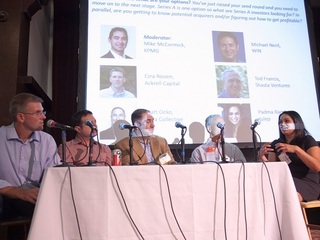At Splash: The philosophy of criticism and praise
The CEOs of two rising LA startups talk constructive criticism and company policies
Read more...Duncan Davidson, partner at Bullpen Capital, took the stage at Venture Shift to give a "State of the Union" presentation on the VC landscape. Is there a Series A crunch? You bet there is, according to Davidson. In fact, it's a "cliff!"
Here's the transcript:
Paul Martino: Yeah, so thank you everybody. On this panel Mike, Ezra, Matt thank you for your on-time arrival. I appreciate that. Our wine here on the left yet from Tess we’ve got them from Bread & Butter, all our panelists will get a bottle. I’m gonna’ take my crack at your question as I get Duncan ready for the next one.
I tell first timers all the time that there’s exactly two things that venture people invest in. They invest in Star Founders and they invest in products with traction. So you better be one of those two things. Be a Star Founder or be a product with traction. If you’re not one of those two, you’re going to have long odds.
So with that, I want to tell you a little bit about what Duncan’s going come up here and do next. This is going to be a very different kind of thing. He’s going to get through forty slides in fifteen minutes and I’m going to tell you what those forty slides are real quickly.
If you run a venture fund, you do this really boring thing once a year called the annual meeting or where you get all your limited partners together and you do dog and pony show, and you have a couple CEO’s come in and this and that. And we decided that ours last year that we have Duncan give a little talk about what he thought the state of the venture world look like and it was such a hit with our LP’s that they said “That’s really interesting, why you don’t share that publicly?”
And we went out and we published the deck and Duncan got hundreds of emails back. And so, six months later our annual meeting was in December, we went, we updated the deck with new data. And I really think the presentation we’re going to see over the next forty slides is going to be one of the most jam packed data festivals you’re gonna’ see about what the actual state of the universe looks like in raw numbers, not just platitudes and subjective statements.
So with that Duncan, you better live up to the billing promised?
Duncan Davidson: Thanks a lot, you could have undersold not oversold it.
Paul Martino: Okay.
Duncan Davidson: Everybody pay attention, we’re gonna’ go fast here. Let’s start, ‘Series A ‘crunch’. It’s real. It’s here. Let me show you the data. Let me show you the data. Okay. I look and try to get the best data. CBI insights did a real scrub just for this purpose. Not for me but for the outside world. The blue is ‘Seed’, the red are Series A and they scrub that all the crap. There’s no clean tech, no pharma, no big heavy metal enterprise type of deals, this is the type deals we’re all doing here. Now what you see is what you kind of expect. Okay, there’s more ‘Seed’ than there are A’s, they must fall to the floor. But wait a minute, they’re showing 2010 to 2010 and 2011 to 2011. And if you do a ‘Seed’ in 2010 you’ll going to raise money from ‘A’ in 2010? No! You’re gonna’ go the next years. So I shifted the data.
Now take a look at this. Take a look. We were in alignment for the first three years of this craziness. If I did this on a quarterly basis we were actually in alignment all the way into the second quarter of 2012. Oh my God, what happened then? I tell you in a minute.
What’s happen now is the A has cooled off. The ‘Seed’, these are all deals done last year, and this year the ‘Seed’ is still going pretty strong. So what everybody says is a ‘crunch’ is actually a ‘cliff’ and a lot of deals are about to fall off the ‘cliff’. Let me show you what happened: okay we all know Facebook, Faceplant, it’s a train wreck and a train wreck in a venture market so the capital market looks like this.
First they hit their little wall, everybody gets upset. Groupon didn’t do so well. I’m sorry. There’s Zynga people here, they didn’t do so well. Suddenly the next stage after the public market, the late stage people got ‘Fomo’ chill. Now ‘Fomo’, you guys know or ever hear of ‘Fomo’? Have you ever heard this word? For those who don’t know, Fear Of Missing Out. So some of the most venerable names in venture capital before Faceplant jumped in the deals like Facebook, like Groupon, like Twitter at exorbitantly high evaluations because “they had to be in it.” Fear Of Missing Out!
Now for all of us, we should all embrace ‘Fomo’. ‘Fomo’ is what creates a big tech bubble. Tech bubbles create your rational returns to you and to me. So ‘Fomo’ is good. But ‘Fomo’ died with Facebook in this era. Now look, the chill of ‘Fomo’ is immediate, I’ll show you some data. The series A guys, they sort of felt the chill from the later stage growth funds. They got cool, about a quarter after that the ‘Seed’ funds begin to say “Wait a minute, wait a minute.” The series A guys are not in alignment anymore. What we’re going to do?
We at Bullpen follow the leading ‘Seed’ funds. We begin to see a noticeable decay in the quality of referred deals. They literally got into the shit, they were not sending us that before, why? They begin to hide their really good deals, bridge them, take care of them, hide them from other people to make sure they can get pass this little series A ‘crunch’.
And then accelerators, we all saw this news, we saw this news right? Paul Graham said “You know A.D. deals about too big, we’ll cut-back a bit or maybe a hundred-fifty I forget.” They cut-back too and then Angel guys down here began to cut-back. That’s where we are. We’re at the end of the train wreck. So the question is, is this thing going off the rails or not? I’ll answer that question in a minute.
Here’s the immediate reaction, the ‘Fomo’ reaction. You can see this from the Fenwick data. That or up-rounds, these are down-rounds and flat-rounds. What do you see happened? Bamm! Fewer up-rounds more down-rounds. More flat-rounds; an immediate reversion. And then it stabilized a bit, which is good news. This is data for the venture industry, what you see here is the number of deals kind of flattened us off, the dollar’s dropped quite a bit.
It’s not like 2000, I lived through 2000. It’s not that quite that bad yet. I looked at other data, there’s no real canonical data for venture. You’ve gotta’ look for your data. This just came out from Pitchbook, it shows a more dramatic drop in the number of deals. You could see the number drops since Faceplant. And the dollar’s drop and they’re somewhat easing up a bit right now.
I looked inside the data, okay we’re talking about the series A, let’s take a look. This is so hard to see, the red is series A, this is C, there’s the later stage. It’s a hundred percent so it’s all deals and how they’re distributed. And what you see is, down here, Seed exuberance. Through here, A was doing okay and it increases a bit but in the second quarter you normally see a bit of an increase in A. You just see a little bit of a season out in the venture business. You know in the third quarter, when you everyone goes on vacation, so you get some other deals in the fourth quarter. And everybody goes away in the first quarter.
Okay. How many deals will fall to the floor? Now look at this chart. It’s one of these crazy McKinsey style charts. Nobody should try to understand it. But look at the following. The first bar, 2200 to 2300 ‘Seed’ deals after two years. The last bar which you cannot read, I’ll read it for you, somewhere at the low side of 994, the high side 1473. Let’s say 1000 to 1500 are threatened to fall to the floor. So that’s more than half in most scenarios. That’s pretty bad. So what’s the market gonna’ do? Do you guys remember Jurassic Park or is that so long… who remembers Jurassic Park? Okay, good!
Do you remember what the chaotician said when they ask him “is the park safe?” Remember when he said? “You don’t understand. Life will find a way.” All right, capital markets are like Jurassic Park. They always find a way, and they’re finding a way around the ‘crunch’. Here’s some other data, ‘Seed’ follow on how much went to the traditional venture? How much went to the alternative world, the Bullpen world, the venture shift world, our world?
What you see is a demonstrable drop in the funding from the traditional world. And an interesting increase in the alternative world, so that, in 2012 when we still had half ‘Fomo’, it’s almost the same. Obviously, I don’t have data for this year, but I’m – what I’m seeing in the market tells me the alternative world may be funding more in the series A, than would be the normal series A round position.
Okay, let’s pull up and go to the VC industry. Reid Hoffman is a great man, he’s made this statement there’s always this argument… Matt Ocko I think talk a bit about it… but the argument is always this “Have things really changed, is this time it’s different or is it just cyclical or go back to the old ways?” Well there’s some arguments I will make, I’m normally a cyclical kind of guy. But I think in this case we’re seeing something fundamental.
This is not just major ongoing disruption. I should have written, “this is the greatest disruption of the venture industry in thirty years.” Just take a look at it, so first of all, oh my God. Don’t look at the slide for a minute. You guys all think it’s easy to be a venture capitalist, right? It’s not, it’s not easy. I’ll tell you why. This is the data we get from Cambridge Association of how we’re doing.
Can anybody understand this? I mean, they could have done InterPro graphic, they could have use an Excel and made a chart. They gave this piece of crap! Or let me simplify it! If you would have put your money in a Spider Fund and ETF for the S&P in 2000 or 2001, look what you have made. In return you put your money in all those great traditional venture funds, your returns would have sucked. Would you rather take 30% with no overhead, with no brain damage? Or 13% you had to pick the right fund, anybody?
As a consequence of this, the venture industry has been consolidating rapidly… and this is the best data I found. This is data of active venture funds, there’s a lot of venture funds that exist. They don’t do anything, they’re sitting on money, and they’re gathering fees. You can see how much is collapsed and venture funds don’t die immediately. They have 10 years of money. So they linger on and they do a little bit, they putt around. But these are the active funds right now. Now we look inside this number, this number is all over 200. It includes both the new breed, the ‘Seed’ funds, and the old traditional funds.
We have actually seen other data which says they’re only around 85 traditional fund managers in the United States that stay really active. When that number was a 1000 way back in the good old days, and we’ve also seen from the deal flow we get at least eighty-five ‘Seed’ funds or something like it more than just the wacko angel but institutionalize group. So we think that the new breed is actually equal to the old breed and there’s somewhere in the range of a 150 to 200 existing fund managers now. But that’s a real drop from where it used to be. But is that bad news? Not really.
The second thing that happened here, lean finance evolution, I’m sure you guys have been exhausted with all the lean finance, lean start up crap, product market fit. I won’t repeat it, except to say this, if you were a venture ‘dude’, I’m sorry ladies, they’re almost all ‘dudes’, that’s really tragic. If you’re a ‘dude’ back in 1999, you would think you needed $5 million to start a company.
And you have to go to a traditional venture fund, get your $5 million dollar A round. By 2005 in the web 2 dot era, it was about 500k why? Open source, cheaper hardware. In 2010 it was 50k, now two girls or guys in a dorm room could start a company, run it on Amazon and launched it. Really cool. This is what made a profound change in the venture business.
Now the guy I think really got this more than anybody else, Josh Kopelman. So I’m gonna’ celebrate him for a minute. He sort of understood that when the A round was no longer 5 million but now maybe 500k, you could play venture differently way. The old way of playing venture: where a lifestyle invest – lifecycle investor- will stay with your company for seven or ten years. We’ll make sure you got a good exit. Okay. The new style: what the hell! We don’t know if you got a good idea or not it’s just an experiment. We’re gonna’ buy an option, give you 500k and go see what happens.
You know if it fails, why don’t you give up fast and go do something better? Don’t sit here and beat your head against a wall. This is a different attitude for different venture and it fits this model of lean finance and it’s hyperactive. Traditional venture fund about the size of Josh’s fund would do maybe four deals a year. He does forty.
I’ve looked at data on the hyperactive funds vs. non-hyperactive, this is the pace you need to be an option buying type of VC like Josh which is not really that many for the last five years. Most people are still on traditional way but these are the funds that are driving the business right now. And these funds have ceased the front end of the process. We all talk about getting to the A round, isn’t that what you should be doing?
Well actually the ‘Seed’ round is the new A round. That’s the first institutional money and with the new A round used to be. And if you get that you’re at whole different ball game than if you don’t. What happened to this whole business with lean finance? Take a look at this data: it used to be the deal sides of around 4 million. ‘Seed’ A, everything all thrown together. Recently it’s down about 2 1/2 going down to 2. What is this do? Let’s say you’re a manager of a $600 billion venture fund and you have a bunch of partners. And you could do a lot of deals at a million dollars.
Okay, do I want 600 deals in my portfolio? I have to hire a lot of other people to run my portfolio. No I don’t! I don’t want to really do these little deals. I want to put at least 5 and of not 10, so at right sizes to the size of my fund. So the big funds had to move later. They have no choice. They couldn’t do the million dollar ‘Seed’ around. They couldn’t really do the round after two to three million, it’s just not enough room in it for them. They needed to wait for the five to ten million dollar round. Now that created this alternative venture industry.
You can see Accelerators, Super-Angels, Micro-VC’s, a lot of these names you know. Bullpen is up there. This is a new industry taking advantage of the structural change of the venture market. We started Bullpen, this by the way is a native advertising just for a minute. We started Bullpen because we anticipated this three or four year ago. We saw this coming and so we now see the market all differently.
So what people really need is a small round to follow the ‘Seed’ round. If you get it right, then you can go raise a big around, 10 or 12 million dollars. I call it the ‘shovel in’ round, and sort of bypass what the A used to be. You still go to the A funds, they have $600 million, they’d rather write a $10 million check. But you don’t think about the process, “ah I got to get to the A round.” No, you think about the process. Part of market fit, “can I validate my business, do I deserve the ‘shovel-in’ money?” Then go get it, and then you go like crazy and grow as fast as you can.
All right, prognosis going forward. I’ve got two minutes – the two-minute warning I guess from the hockey game. Now let me go fast, first of all here’s the good news, the train wreck is really over. Oh my God, not one of this charts again. First thing I’ll tell you about the Cambridge associates chart, venture returns are improving for the first time in ten years.
What does this mean? Venture returns are improving and there’s fewer funds. Guess what that means? More… the liquidity ratio, money-in to money-out is improving as well. This is making venture a better business. It’s been the right sized. Okay public markets: that’s what a bubble looks like. The blue line, the Nasdaq the black line the S&P, the broader market. That’s ‘Fomo’ in a graph. What happens here? The Nasdaq has greatly outpace the S&P, just in the last few years.
This is the signature of money rotating into our world. And it’s what should – what we should be seeing right before we go through another wave of whacko IPO’s. Exits are getting better, you can see here the numbers increased and the dollar size increased. It’s been some pretty big numbers. If you look at 2013 recent data, the red are IPO’s. Twenty-two IPO’s in this second quarter more than any quarter in the last year and a half. Then the Wall Street Journal came up with this so that – they’re not one to miss the trend- that’s the headline. You guys see this? It was just last Sunday or two weeks ago, “The New Wave Of IPO’s.”
What the data says is this: in the first half of 2013 more IPO’s happened than any of the first halves after 2007. We were in a huge housing bubble. So if you project this out we should have the best time for IPO’s since back in 97’ – 98’. So the best way I could summarize where we are right now, its 1997 going 1998’ guys. Hold on to your wallet or something. It should be a lot of fun. Thank you.

Woman of many skills: Database System Engineer; SplashX event producer; Author of Startup Teams
All author postsThe CEOs of two rising LA startups talk constructive criticism and company policies
Read more...Real estate realities and the importance of office culture
Read more...At Vator Splash Spring, CEOs and founders from Mayvenn, VSCO, and Dictionary.com share their stories
Read more...
Joined Vator on

Joined Vator on
Duncan is a serial entrepreneur turned venture capitalist who co-founded Bullpen Capital, a seed fund which focuses on the "post seed" round to get to a Super-Sized A round



